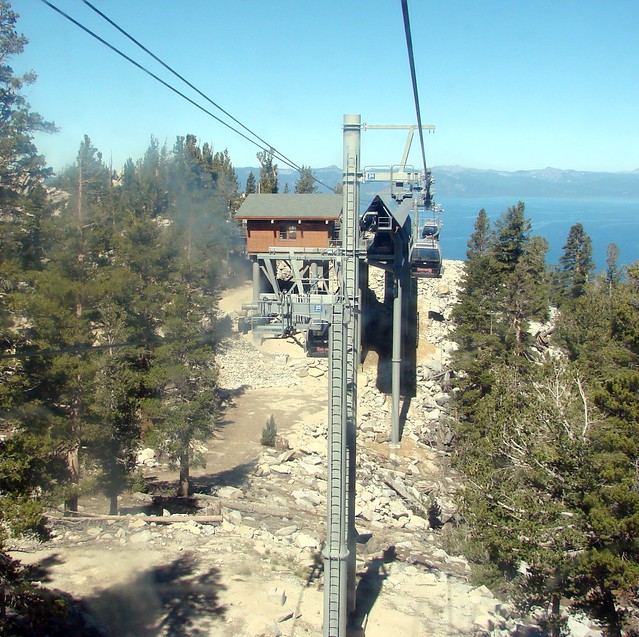This is a guest post by Billy Beasley.
It is the second article of a two-part series examining innovative station designs found in recreational cable cars that could be useful for urban implementation. Click here for the first article.
Heavenly Mountain Gondola (Nevada)
In some situations, cabin parking may not be an issue — rather, it’s how to build a station in a terrain-constrained location.
One unique solution may be to literally “cut it in half”.
This technique is used on many gondola systems but I’ll examine the gondola at Heavenly Mountain in South Lake Tahoe which takes guests from the resort village/hotels to the mountain.
The mountain wanted a mid-station on top of the ridge which has beautiful views of Lake Tahoe but instead of constructing a full station, they only built the mid-station for the side of the lift that was going up.
The uphill side of the line stops at the viewing deck but the downhill side travels down without stopping, saving time on the downhill ride time, space and money because only one side of the terminal and terminal equipment is being built. This was especially practical for Heavenly since there was no natural flat spot on the ridge so the deck had to be built sticking out from the side of the ridge. This would have meant that if the other side was built, the deck would have to be longer and stairs would have to be built to get to the other side where the best views are as well as shops and restaurants.
This could be useful in a tight urban space where there isn’t enough room for a full mid-station but access is required in one particular direction.
Some aerial tramways terminals have shifting unloading platforms so only one tram unloading dock needs to be built instead of two. This technique conserves space and would be helpful for an urban gondola in a tight situation.
Skyeship Express Gondola (Killington, Vermont)
Killington, Vermont’s Skyeship Express Gondola is a two-stage gondola that can be run two different ways: as one continuous gondola or as two separate systems. At the mid-station, the cabins will either turn back around and go back down the line and the lift functions as two totally different system or the cabins continue on to the second stage and the lift functions as one big system.
Check out Ski-Lifts.org for pictures of the mid-station and system design.
This could be useful for an urban gondola that wants to alter its route for traffic and flow patterns. For example, running the lift as two different sections in the morning and rush hour for peak times and running it as one big system during non-peak times.
Breckenridge Quicksilver Super6 – Double Loading (Colorado)
Double loading can also be used, which alternates cabins between two different loading areas to improve station efficiency. Breckenridge’s Quicksilver Super6 was the first American lift to utilize double loading. As the chairs come into the terminal, one turns and heads back up the mountain like a regular detachable lift while the next chair travels onto another lift loading area and this continues on in an alternating pattern. The chairs from the lower loading section of the station then rejoin the line of the upper loading section and the chairs travel up on one line then unloads like a regular chairlift.
Check out Colorado Ski History for great overview and pictures of this system.
The upper loading section is used for guests coming from the mountain and the lower is used for guests from the town and nearby hotels. The two loading zones have separate loading cues and separate loading locations so there is no intermingling or confusion between lines. This could be used on an urban system where passengers are coming from two different areas or in situations where having two loading areas are necessary to ease congestion.
But if all else fails and nothing else works, you could just put that terminal in the side of a mountain, like what was done on the Huashan Xifeng Cable Car in China!
Thanks to skilifts.org, coloradoskihistory.com and doppelmayr.com for the information and thanks for reading. Feel free to comment what you think and have a nice day.
Become a Contributor, Write a Guest Post.
For more information check out the Get Involved page here.


1 Comment